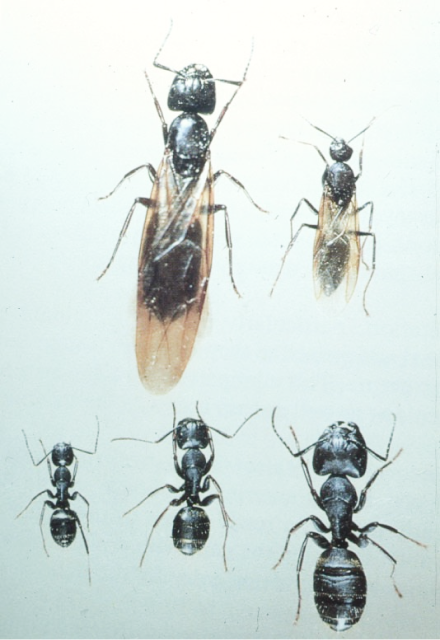DO YOU HAVE CARPENTER ANTS LIVING IN YOUR HOME?

CARPENTER ANTS 101
HOW THEY LIVE
Carpenter ants create and live in colonies that can have several nest site locations spread out over a large area. Piles of dead wood, trees, and stacks of cut wood, in different locations on your property, are all prime real estate. The ants will travel between these nest sites in the warmer parts of the year and create even more. When a colony in the area of your home finds a way inside, it will invade and then create a satellite nest indoors for the colony. You can actually have more than one nest in your home through this process. You may see carpenter ants traveling from your home and across the lawn to a tree were another nest site is located. They will sometimes actually cut a swath through your lawn between your home and the external nest site. Carpenter ants will continue to reinvade homes from these exterior nests if not treated annually.
WHAT CARPENTER ANTS EAT
The belief that Carpenter ants eat wood is not true and this is why you find piles of saw dust near nest sites. They build their homes out of wood and live in it just like we do. Carpenter Ants actually need the same foods we need to survive – sugars, proteins, fats, water, etc., which is why they are most frequently seen in the kitchen and bath rooms of your house. Simply put – they’re out picking up supplies. Their most abundant food sources are flower nectar and other insects, both found outside. The ants will stop foraging in your house while it’s warm to gather these foods but they still maintain one or more nests in the your home’s structure.
TYPES OF CARPENTER ANTS
There are several different species of Carpenter ants. Some are all black and others may have a red midsection. In any Carpenter ant colony you will find three forms of carpenter ants. The King, which looks like a small wasp, as shown in fig 1 as the smaller winged ant. The King’s life span is short and exists only for breeding . Once having bred the Kings die off. Each nest has a Queen, but the new Queens which occur every year are the ones most people are familiar with. New Queens start with wings as shown in fig 1, which are essential only to leave the nest with. The wings are dropped after leaving as they begin to crawl around looking for a suitable place, like your house, to start a new nest. These are referred to as swarmers. The Queens are found crawling around during the first early warm days of spring for a week or two while they look for nest sites. There can be a 1000 + swarmers in a single nest site. The third type of Carpenter ant is the worker and they are found in different sizes as seen in Fig 1. These ants are the backbone of the colony and the ants that do all of the work for the nests. These ants are the ones that damage your home as they dig through the wood in the process of building the nests. You will find them foraging for food in areas like your kitchen and bath room.
WHAT YOU CAN DO TO HELP STOP THEM
- Trim all plants away from the house. Each branch that touches the home is a bridge for the Carpenter Ants to enter and leave. We want them to have to cross your foundation specifically because that is where the treatment to stop them will be placed.
- Reduce moisture damage to your home. Moisture damaged wood is what carpenter ants prefer to live in. Having Gutters on your home to divert water, and an 18 inch barrier of crushed stone around your foundation this will help reduce moisture damage to your home.
TOWNS WE SERVE
MAINE
- Elliot
- Kittery
- South Berwick
- York
NEW HAMPSHIRE
- Brentwood
- Dover
- Durham
- East Kingston
- Epping
- Exeter
- Freemont
- Greenland
- Hampton
- Hampton Falls
- Kingston
- Lee
- Madbury
- New Castle
- Newfields
- Newington
- Newmarket
- North Hampton
- Portsmouth
- Rollingsford
- Rye
- Seabrook
- Somersworth
- Stratham
AWARDS & RECOGNITION


What Our Client Say About Our Services
GET IN TOUCH WITH US
Existing customers please contact us at info@ecotechpc.net.
Please note that it may take 24 hrs for a response by email. The quickest way to reach us is to call 207-451-9451.
Please make sure the property you wish treated is in a town we service